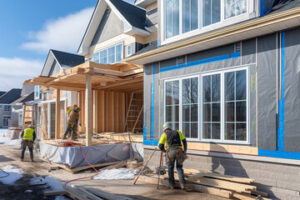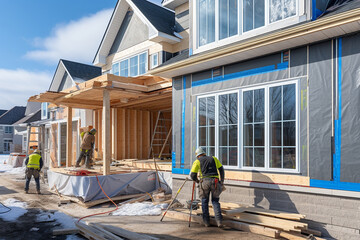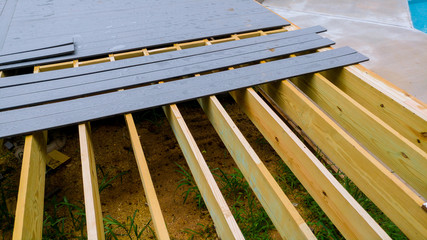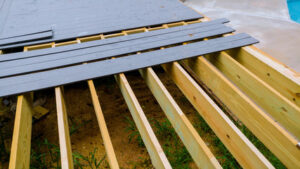House painting is one of the quickest, most affordable, and most effective ways to update your home’s appearance. It can also add value to your home.
Legitimate house painters are transparent about the materials and methods they use to achieve their results. This prevents bait-and-switch tactics and ensures that you’re getting a quality paint job. Contact Modesto House Painters for professional help.
Professional house painters are skilled at painting techniques that deliver high-quality results. They understand the importance of using primer, maintaining a wet edge, and lightly sanding between coats to achieve smooth surfaces. They also know how to use a brush or roller with the appropriate nap for various surfaces. The result is a flawless, long-lasting paint job that will beautify your home for years to come.
In addition to their technical skills, house painters are able to offer excellent customer service. They will respect your property, minimize disruptions to your schedule, and maintain open lines of communication throughout the project. Additionally, they will provide a warranty on their work to ensure your peace of mind and satisfaction with the finished product.
Exterior house painting can be an intimidating task for homeowners. Whether you need to repaint the front door or update the entire exterior, hiring a professional house painter will save you time and money. A professional will be able to identify any underlying issues and recommend the best solutions for your home’s needs.
When it comes to interior house painting, a fresh coat of color can brighten up any room and make it feel new again. Many interior painters specialize in popular trends and can help you find the perfect look for your space. Additionally, they can help you choose durable materials that will stand up to repeated use and cleaning.
In addition to their painting expertise, professional interior painters will use top-quality paints and equipment. They will also take the time to prepare your surfaces for painting, and they will make sure that all of your furniture is covered or moved out of the way before beginning the project.
Save Time and Money
Professional house painters know how to work quickly and efficiently, saving you time and money as compared to a DIY project. Plus, they’ll use high-quality paints and equipment that will last longer than cheap alternatives. Moreover, they’ll take care of cleanup and disposal of materials, leaving your home spotless.
A new coat of paint is a great way to refresh the look and feel of your home. Interior house painters can recommend trending colors that will make your rooms feel larger, cozier, or more vibrant. Furthermore, they can give you valuable insights on color based on your home’s architecture, style, and surrounding environment.
Hiring a professional house painting service is also an excellent way to protect your investment. Experienced painters will prepare the surface correctly, including filling holes and cracks, sanding, and priming, to ensure the paint adheres and holds up over time. Additionally, they’ll use the proper tools and techniques to apply a smooth, even finish that looks great and resists moisture.
Before starting the project, it’s important to remove any furniture items that can be moved and cover any items you don’t want painted. This will save you the hassle of moving and re-hanging items afterward, and it also prevents accidental damage to your belongings. Additionally, it’s a good idea to move all the small items like nightstands and coffee tables to a separate room or garage. Finally, it’s a good idea to wrap large items such as beds and sofas in bubble wrap to protect them from scratches and marks.
Reduce the Risk of Injuries
Painting may seem like a low-risk occupation, but there are still many hazards that can pose serious problems. For example, working on ladders or scaffolding poses the risk of falling, which could lead to injury or death. Also, prolonged exposure to paint fumes can cause headaches and other health issues. Proper ventilation is crucial for reducing the impact of these hazardous chemicals.
Professional house painters are well aware of the risks and take steps to ensure their safety and the safety of those around them. They wear proper clothing and equipment, including gloves, masks, goggles, and protective equipment. They also make sure to cover all surfaces and furnishings before they start work. They will also carefully clean up their work area before leaving. This prevents accidental messes that can damage your furniture or other valuable items.
Painters also have access to a wide range of tools and materials that can help them achieve unique and stylish results. They stay up-to-date on industry trends and are able to recommend the best colors and finishes to keep your home in style.
Almost all professions involve occupational hazards, but the risks of working as a house painter are greater than most other types of jobs. Workers are at a higher risk for falls, exposure to harmful substances, and other dangerous conditions. Fortunately, employers must adhere to strict standards of safety and have workers’ compensation insurance for their employees in case of accidents.
Hiring professional painters is the safest way to ensure a high-quality, long-lasting paint job for your home. They have the experience and expertise to provide a quick and efficient service that will add value to your property while saving you time and money.
Save Money in the Long Run
House painting is one of the most cost-effective ways to update your home. Professional painters use high-quality paints and materials, which provide long-lasting results that add value to your property. In addition, they can save you money in the long run by completing the job quickly and efficiently. They also know how to prepare surfaces for painting, including filling cracks and holes, sanding, and priming. This allows them to apply fewer coats of paint, which can cut costs in terms of both material and labor.
Additionally, professional painters are familiar with the latest trends in interior design, so they can advise you on color options that will complement your space and fit in with current décor. They will also be able to recommend specific types of paint that are durable and easy to clean, which can reduce future maintenance costs. Finally, a good painter will come with all of their own equipment, saving you the cost of purchasing or renting the tools you may not need on a regular basis.
Painting costs vary depending on a number of factors, including the size of your home and the complexity of its interior features. For example, walls with detailed trim or textured surfaces require extra time and materials to prep, which can increase overall project costs. It’s important to ask a painter to provide you with a detailed estimate before committing. This will help ensure that all of the costs associated with your project are clearly outlined and that you don’t encounter any surprises down the line.
It’s also worth noting that many painters offer discounts during off-peak seasons, so be sure to ask about potential savings opportunities. Additionally, be sure to negotiate prices before settling on a final quote.
Add Value to Your Home
A fresh coat of paint can make a home look new and feel brand-new, and it’s one of the most cost-effective ways to add value to your property. In fact, studies show that a home’s value can increase by several thousand dollars after a professional paint job.
Expert house painters know how to prepare and treat different surfaces, including woodwork and trim. They also understand color theory and can help you choose the best colors for your space. In addition, they’ll use the right techniques to achieve a long-lasting and high-quality finish that will add value to your property.
They’ll also address any structural concerns and recommend the best products and materials to use for your project. In many cases, this will save you money in the long run because you’ll avoid costly repairs or replacements down the line. Local painters will also be familiar with the local climate and weather conditions, ensuring your paint job will last longer and resist damage from UV rays and other environmental factors.
When choosing a painting contractor, ask for a detailed estimate that includes labor and material costs. Compare quotes from several painters and choose one with the best reputation for quality work, customer service, and trustworthiness. You may also want to consider how long the company has been in business, as this can indicate their level of expertise and reliability. In addition, it’s a good idea to read customer reviews and contact past clients to gauge their satisfaction. A reputable painting company will be more than happy to provide references from past customers. By following these tips, you can ensure that your next painting project will be completed professionally and efficiently, adding value to your home in the process.










